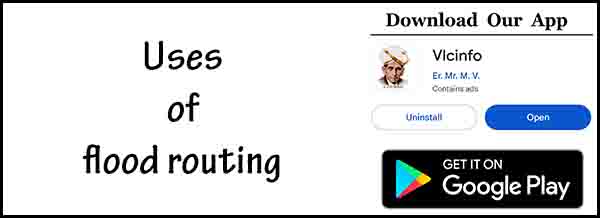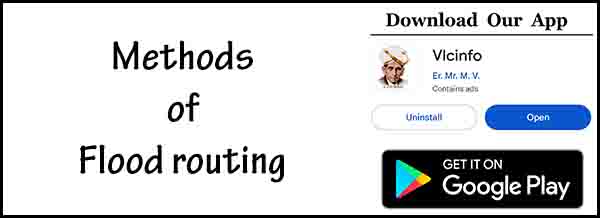Here you will get details about “Flood Routing And Uses of Flood Routing. We have listed all uses here in detail. Here you will get all details about Flood routing. Keep visiting – Vlcinfo.
Flood routing
- Flood routing refers to the process of predicting the behavior of floodwaters as they travel through a river channel or across a floodplain.
- Flood routing is a simple procedure to determine the magnitude and time of flow at a point on a waterbody from known or assumed hydrographs at one or more points upstream side.
- The procedure is specifically known as Flood routing, if the flow is a flood.
- The main purpose of flood routing is to understand how floodwaters will evolve over time and space, which is crucial for effective flood risk management and mitigation strategies.
Uses of Flood Routing
- In the location and sizing of the capacity of reservoir to meet specific requirements.
- Flood routing helps assess the potential environmental impacts of floods on aquatic habitats, water quality and riparian ecosystems.
- It is used in hydrology for forecasting the variations occurring under the oceans and other water bodies, by observing their current activities.
- Flood routing is used in risk assessment studies to quantify the probability and consequences of flooding for different scenarios.
- It is used to compute the reservoir storage, volumes, outflow rates and water levels in the reservoir corresponding to a particular hydrograph of inflow.
- Flood routing is used to design and assess the effectiveness of flood control structures such as levees, dams and reservoirs.
- In the design of the capacity of spill ways and other reservoir outlet structures.
- By simulating the movement of floodwaters through a river system, flood routing helps in forecasting the timing, magnitude, and extent of floods downstream.
- It is a useful technique for obtaining complete solution of flood control problems.
- Flood routing provides insights into how floodwaters will inundate and interact with floodplains.
- It is used to obtain a hydrograph as moderated or modified by a reservoir when a particular flood passes through it.
- Flood routing is an essential component of hydraulic modeling, which is used to analyze the behavior of rivers and streams under various flow conditions.
Methods of Flood routing
There are several methods of flood routing used in hydrology, each with its own assumptions, complexities and suitability for different situations.
Muskingum Method
- The Muskingum method is a widely used and simple flood routing technique, particularly for one-dimensional flow in rivers or channels.
- It involves dividing the river reach into segments and applying storage and routing coefficients to estimate the outflow hydrograph.
- This method is relatively straightforward and computationally efficient but may not capture complex flow dynamics accurately.
Empirical Methods
- Empirical methods rely on historical data and empirical relationships between flood hydrographs at different locations within a river system.
- These methods are often used when detailed hydraulic data is limited or when a quick assessment of flood routing is required.
- Empirical methods may involve simple regression analyses or the use of rating curves to estimate flood routing parameters.
Muskingum-Cunge Method
- The Muskingum-Cunge method combines the Muskingum routing technique with the dynamic wave approach.
- It improves the accuracy of flood routing by incorporating additional parameters to account for channel storage and friction effects.
- The Muskingum-Cunge method is commonly used in hydraulic modeling software for simulating floodwave propagation in rivers and channels.
Dynamic Wave Routing
- Dynamic wave routing considers both the spatial and temporal variations in flow velocity and depth within a river reach.
- It solves the full dynamic wave equation, accounting for inertia, friction and channel geometry effects.
- Dynamic wave routing is more computationally intensive than kinematic wave routing but can provide more accurate results, especially for highly transient flow conditions or channels with irregular geometry.
Kinematic Wave Routing
- Kinematic wave routing assumes that changes in flow velocity within a river reach are instantaneous compared to changes in flow depth.
- This method is based on the kinematic wave equation, which simplifies the dynamic wave equation by neglecting inertial effects.
- Kinematic wave routing is suitable for relatively uniform and gradual channel reaches but may not be appropriate for highly dynamic or rapidly varying flow conditions.



